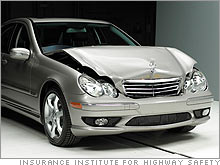NEW YORK (CNNMoney.com) -- In tests designed to replicate low-speed impacts, the bumpers of several luxury cars failed to prevent costly damage. In one case, a Mercedes-Benz C-class sedan sustained almost $5,500 in damage when hit in its front bumper at a speed of just 6 miles per hour.
The Insurance Institute for Highway Safety conducted four separate low-speed impact tests on 11 popular luxury cars.
 |
| Mercedes-Benz C-class following 6 mph front impact test. The C-class performed poorly in this test, Mercedes contends, because its bumper is designed to minimize injuries to pedestrians struck by the car. |
The cars struck a barrier, designed to mimic the bumper of another car, straight-on from the front and from the rear at six miles per hour and diagonally into front and rear corners at three miles per hour. The Institute, a private organization funded by insurance companies, estimated repair costs after each test.
"[W]hat the test results don't reflect is the Mercedes-Benz holistic approach to occupant safety," Mercedes-Benz said in a statement. "This philosophy influences design and development even down to the front bumper, which is specifically mounted lower to help reduce injury for impacts with pedestrians (to avoid contact above the knee)."
The C-class performed poorly in large part because its front bumper slid down below the impact barrier during the test.
The vehicle sustaining the most total damage was the Infiniti G35, made by Nissan, which had total estimated repair costs of $14,000. In the straight-on front impact test alone, the G35 sustained $5,223 in damage.
"The cost of vehicle ownership and repair are important considerations at Infiniti," Nissan said in a statement. "We design each new model to resist low-speed collision damage and will continue to work closely with major insurance companies to keep premiums low for our customers."
The Insurance Institute's tests do not reflect likely real-world results, Nissan said.
The best-performing vehicle in the test was the Saab 9-3. Its total estimated repair costs for all four tests was $5,243, less than what the Mercedes-Benz would have cost to fix after just one front impact.
The Institute wasn't enthusiastic about even the Saab's performance in these tests, however.
"There's nothing exemplary about even the best performer, the Saab 9-3," said vice president Joe Nolan in a statement. "It simply avoided racking up the most damage in any single test and ended up coming out the best in a mediocre lot."
Saab said in a statement that it was proud of the 9-3's top-ranked performance in these tests.
In an earlier round of tests, released in early March, midsize non-luxury cars didn't fare much better. A Nissan product was the worst performer in those tests as well with the Nissan Maxima suffering a total of $9,051 worth of damage.
Many luxury and non-luxury cars suffer from the same problems, according to the Institute: bumpers that are simply too weak, impact absorbing structures that don't extend far enough to the corners and bumpers that are designed with visual appeal rather than damage control as the top priority.
Underneath body-colored plastic exteriors, most bumpers have metal beams that are supposed to absorb crash forces. These beams can be too weak or not placed where needed to adequately protect against various types of impacts.
In some cases, the Institute said, car bumpers can slide under the bumper of another vehicle during an impact, exposing headlights, grills and body sheet metal to damage.
Luxury cars have the additional problem of expensive replacement parts. A headlight for a Lexus ES costs $1,046, according to the Institute. (Headlights were damaged in 15 or the 22 front impact tests the Institute conducted.) The front bumper cover for an Audi A4, one of the best performing vehicles in the tests, costs nearly $600, according to the Institute. That doesn't include installation and painting costs. 